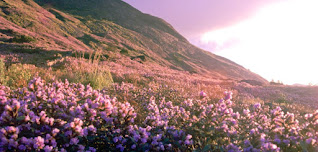The ancient tradition of this land recognised six stages/phases in the annual cycle of weather changes. The classical literature of the sub continent celebrates nature in all its aspects - the scorching Sun is as glorious as the balmy colourful spring or the cool air of the Hemant (autumn).
The flora and fauna enhanced the narration of the human emotions; the keen observation of every being around them brought the appreciation that they were part of the whole creation; and all the animals, birds, trees, flowers, the air, earth and the rain were their kinsfolk; each being loved to live in harmony with all other beings. This idea may sound highly romantic or idealistic, but this is my perspective when I read and enjoy these classical creations. 
In the past, I had never noticed the onset of Spring or the season of Vasanth keenly as the larger part of the year is hot here. We are located well within the tropics and close to the Equator. But now, I feel and experience every small change in the flow and speed of the wind. Each slight shift in the supporting and holding feel of the earth beneath my feet reverberates in a sharp manner. I am able to recognise how even a small blade of grass, the creeping centipede, and the rustling leaves of the Peepal tree standing close to my balcony, get ready to receive the changes in the air around them.
The plants and trees shoot new leaves, and flowers bloom in riot of colour all around me. There is a subtle lilt to the chirping of the birds. The bird songs are like the singing of the singer, who has suddenly found her confidence and shed her shyness.
The pictures that friends share of their gardens have enhanced this awareness. After I see these, so many thoughts associated with seasons emerge in my mind. I keep thinking of the descriptions of seasons and different time of the day in Sangam literature (Tamizh). The collection of poems from the broad period between 3rd century BCE to 350 CE is known as Sangam literature. We get to know a lot of the socio-cultural life of the people inhabiting present day Tamil Nadu and Kerala. The poems depicting human emotions, mainly love, were composed in the backdrop of five kinds of terrain - mountains, forest or wooded land, arid land, plains mainly given to agricultural activities and sea and coastal areas. The narration of these stories used the flora and fauna of the region as symbols to hint upon the emotions.
Each verse - four lines or six lines - is a complete short film with 2 or 3 frames. There is no one word or syllable that is redundant. One poet compares the leaves of Nochi(நொச்சி) (Chinese chaste tree) to the feet of peacock and the soft falling of the colourful cluster of flowers (glowing like sapphires) during night. The point of focus here is the keen sense of alertness with which the lady and her friend (सखी) were waiting to hear from the lover. ( I thank Palaniyappan Vairam Sarathy for this detail from his blog 'Karka..Nirka', a blog on Tamizh literature.)
When my mind is filled with thoughts of seasons and the natural rhythms, this one word, like a refrain, hits my ears in waves. So I pause and listen... Ritusmaharam' is the word and the 'Barahmasa miniature paintings flash before my eyes.
The tradition of closely drawing from natural events and objects to describe human stories and emotions was a widely prevalent practice all over this subcontinent. Ritusamharam is a beautiful poetic creation of 'Kavi Kalidasa in Sanskrit. It roughly translates as 'Medley of seasons' or 'Garland of seasons'. The poem is divided into six main chapters- each chapter assigned to one season. Yes, the literary tradition mentions six seasons - north or south. (Kālidāsa was a Classical Sanskrit author who is often considered ancient India's greatest playwright and dramatist. Many of us have heard of the names of his famous works like 'Abhijnanashakuntalam', Raghuvamsam and vikramorvashiyam , I hope.)
The equivalent six seasons in Tamizh were known as 'Ilavenil' ( இளவேனில்), 'Mudhuvenil' ( முதுவேனில்) , Kaar (கார்), Kulir(குளிர்), munpani (முன் பனி) and Pinpani (பின் பனி) respectively. Coming back to Kalidasa, one of the greatest magic weavers with words, this work is considered one of his most lively creations. Each of the seasons is described as a pair of lovers experiencing changes in their relations, as the changing seasons of India. The poem starts with summer. In this time of extreme heat, one gets joy through mangoes and the cool moonlit nights. There is a description of how young women try to entice their men. Satyam Jayati's translation interprets the opening lines which speak of summer thus:
"Now is the time of heat! A raging sun
Burns through the day, till pleasant night
Cool and refreshing spreads its sable veil.
The sleeping surface of the limpid pools
Is oft disturbed by plunging bathers, faint
With heat, with amorous dalliance tired."
With powerful imagery the poet brings forces of nature like the scorching sun, streaming rain, frosty and biting cold, the dark moisture-laden clouds, rivers overflowing and rushing to the sea and the numerous variety of birds and animals.
Barah indicates number 12 and 'masa' is month. Barahmasa miniatures depict the cycle of seasons through the 12 months and its deep impact on the lovelorn heart. As someone remarked it is poetry meeting art.
Now comes the question - " But where do we see six seasons? We, in this land of monsoon , can easily recognise only three changes - from summer to monsoon to winter.
In cooler places, we can see the onset of spring, that we do not normally recognise in the south. "
Each small shift in the pattern has been observed, experienced and narrated by our ancestors; they aesthetically and practically divided the 12 months into six seasons of two months each. Every being in the diverse ecosystem is able to feel it, attune itself to the changing rhythm and shift in the environment. (But, sadly, we have lost that ability to feel deeply and intensely, I think.)
Thanks to all my friends (particularly the dynamic 'Sangamitra' and exuberant Girijeswari) who pause to observe the celebrations in nature and share it with me - the burst of colours and the shiny tender leaves, the chirping birds, blue sky and fluttering butterflies.












கருத்துகள் இல்லை:
கருத்துரையிடுக